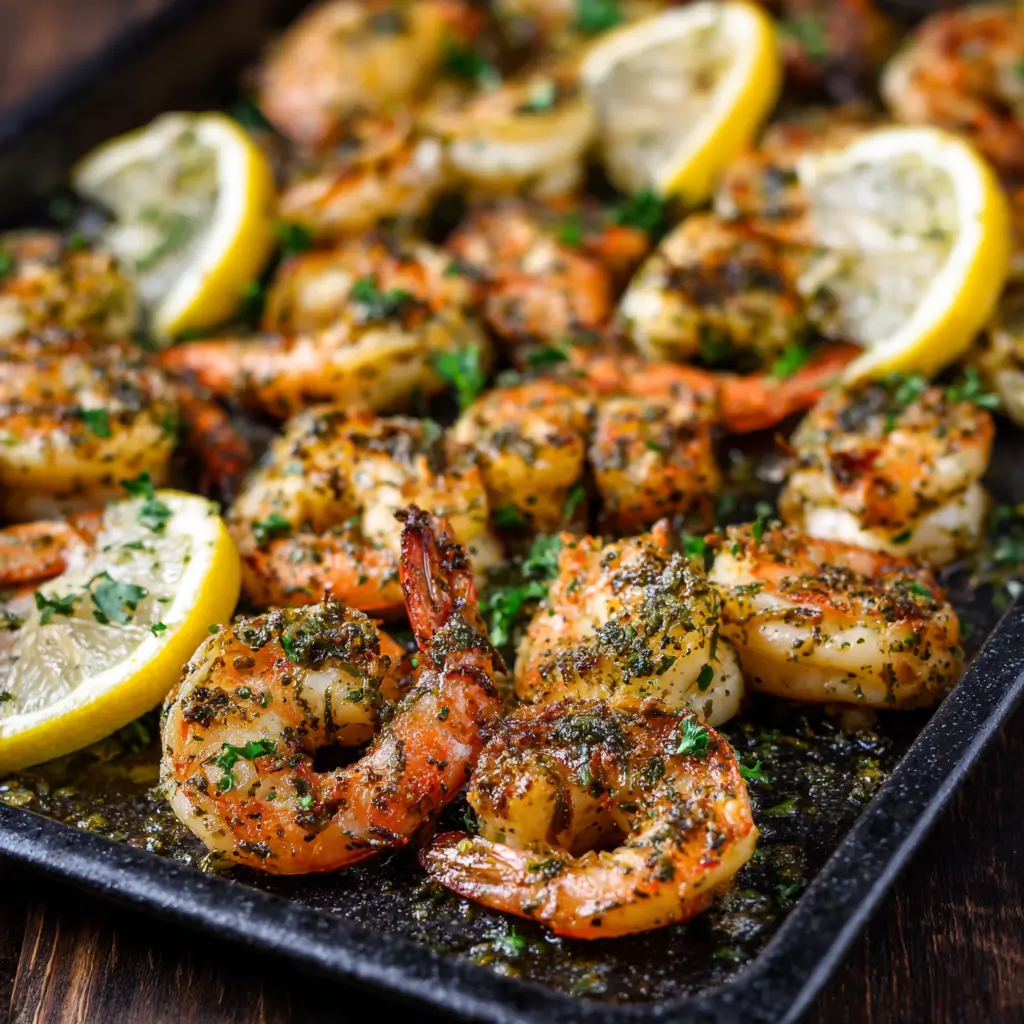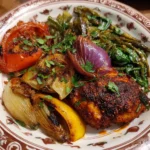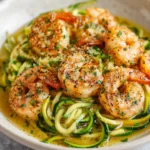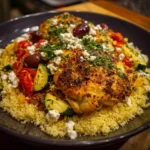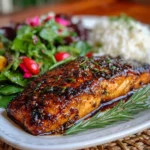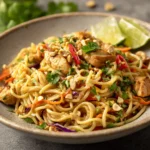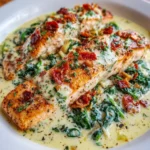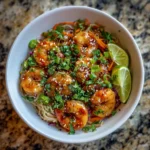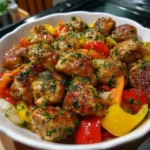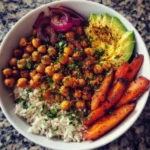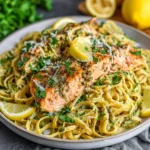Introduction
Sheet Pan Garlic Herb Shrimp is a quick, delicious, and wholesome meal that brings together bold Mediterranean flavors with minimal effort. Perfect for busy weeknights or elegant enough for weekend dinners, this dish combines succulent shrimp with aromatic herbs, zesty garlic, and vibrant vegetables—all roasted on a single sheet pan for easy cleanup. Whether you’re cooking for one or feeding the whole family, this recipe delivers restaurant-quality results with home-cooked comfort. With its balance of protein, healthy fats, and colorful veggies, it’s not just tasty but also nutritious. Let’s dive into everything you need to know to make the perfect Sheet Pan Garlic Herb Shrimp every time.
The History
While shrimp has been enjoyed in coastal regions around the world for centuries—from the Mediterranean to Southeast Asia—the modern sheet pan dinner trend emerged more recently as part of the fast-paced, clean-eating movement of the 2010s. Home cooks and food bloggers began popularizing one-pan meals as a way to save time, reduce cleanup, and maximize flavor through roasting. The combination of garlic and herbs with seafood, however, has deep roots in Mediterranean cuisine, particularly in Greek, Italian, and French cooking, where olive oil, lemon, parsley, and garlic are staples. Dishes like Gambas al Ajillo (Spanish garlic shrimp) and Provencal-style grilled shrimp showcase the timeless appeal of simple, herb-infused seafood. Sheet Pan Garlic Herb Shrimp is a contemporary twist on these classic preparations, adapted for today’s kitchen with convenience and nutrition in mind.
Ingredients Breakdown
The beauty of this recipe lies in its simplicity and the quality of its ingredients. Each component plays a crucial role in building layers of flavor and texture:
- Shrimp: Large or jumbo shrimp (16–20 count per pound), peeled and deveined. Fresh or frozen (thawed) both work well. Look for wild-caught if possible for better sustainability and flavor.
- Garlic: Freshly minced garlic cloves provide a pungent, aromatic base that mellows slightly when roasted.
- Fresh Herbs: A blend of parsley, thyme, and rosemary adds brightness and earthiness. Parsley brings freshness, thyme adds subtle floral notes, and rosemary contributes a piney depth.
- Olive Oil: High-quality extra virgin olive oil acts as a carrier for flavors and helps caramelize the edges of the shrimp and vegetables.
- Lemon: Both zest and juice add acidity that cuts through the richness and brightens the entire dish.
- Cherry Tomatoes: These burst during roasting, releasing sweet-tart juices that mingle beautifully with the oil and herbs.
- Red Onion: Adds sweetness and color; when roasted, it becomes tender and mildly caramelized.
- Asparagus or Zucchini: Optional but recommended vegetables that roast quickly and complement the shrimp without overpowering it.
- Salt & Pepper: Essential seasonings to enhance all the other flavors.
- Crushed Red Pepper Flakes (optional): For a touch of heat—adjust to taste.
Using fresh, high-quality ingredients makes a significant difference in taste and overall satisfaction.
Step-by-Step Recipe
- Preheat Oven: Set your oven to 400°F (200°C). This temperature ensures the shrimp cook quickly without drying out while allowing vegetables to roast evenly.
- Prepare the Sheet Pan: Line a large rimmed baking sheet with parchment paper or lightly grease it with olive oil to prevent sticking.
- Prepare Ingredients: Pat the shrimp dry with paper towels—this helps them sear rather than steam. Cut cherry tomatoes in half, slice red onion into thin wedges, and trim asparagus or zucchini into even pieces.
- Make the Herb Mixture: In a large bowl, combine 3 tablespoons of olive oil, 4 minced garlic cloves, 1 tablespoon lemon zest, 2 tablespoons fresh lemon juice, 1/4 cup chopped fresh parsley, 1 teaspoon chopped fresh thyme, 1/2 teaspoon chopped rosemary, salt (about 1 tsp), black pepper (1/2 tsp), and red pepper flakes (1/4 tsp, optional).
- Toss Vegetables: Add the cherry tomatoes, red onion, and asparagus (or zucchini) to the herb-oil mixture. Toss well to coat evenly. Spread them out on one side of the prepared sheet pan.
- Add the Shrimp: Place the shrimp in the same bowl with the remaining herb mixture (add another tablespoon of oil if needed). Gently toss to coat every piece. Arrange the shrimp in a single layer on the other side of the pan, ensuring they aren’t overcrowded.
- Rosette Placement: Position the shrimp so that they’re not touching—this allows proper air circulation and promotes browning.
- Bake: Roast in the preheated oven for 10–14 minutes. The exact time depends on shrimp size. They’re done when opaque, pink, and slightly curled. Avoid overcooking, which can make them rubbery.
- Finish with Freshness: Remove from oven and immediately sprinkle with additional chopped parsley and a squeeze of fresh lemon juice for a burst of brightness.
- Serve: Transfer to a serving platter or divide among plates. Serve hot, optionally with crusty bread, quinoa, rice, or over a bed of greens.
Tips
- Don’t Overcrowd the Pan: If necessary, use two sheet pans. Overlapping ingredients will steam instead of roast, leading to soggy textures.
- Dry Your Shrimp: Moisture is the enemy of browning. Always pat shrimp dry before seasoning.
- Use Fresh Garlic: Pre-minced jarred garlic lacks punch and can have an off-flavor. Fresh is always best here.
- Add Lemon at the End: While lemon juice is added before roasting, a final squeeze after baking enhances freshness.
- Watch Cooking Time Closely: Shrimp cook very fast. Check at 8 minutes and rotate the pan if your oven has hot spots.
- Roast Veggies First (if needed): If using heartier vegetables like potatoes or carrots, roast them for 10 minutes before adding shrimp.
- Use Parchment Paper: Makes cleanup effortless and prevents sticking without needing excess oil.
- Invest in a Rimmed Baking Sheet: Prevents juices from spilling and ensures even heat distribution.
Variations and Customizations
This recipe is highly adaptable to suit different tastes, dietary needs, and what’s in your pantry:
- Protein Swap: Replace shrimp with chicken breast strips, scallops, or salmon chunks (adjust cooking time accordingly).
- Veggie Options: Try bell peppers, broccoli florets, sliced mushrooms, fennel, or green beans. Mix and match based on seasonality.
- Citrus Twist: Swap lemon for lime or orange for a different citrus profile. Blood orange adds a beautiful color and subtle sweetness.
- Herb Changes: Basil, dill, or cilantro can be used in place of some herbs for a global twist—try dill for a Scandinavian flair or cilantro for a Mexican-inspired version.
- Dairy Addition: After baking, crumble feta or goat cheese over the top for creaminess and tang.
- Spice It Up: Add smoked paprika, cayenne, or harissa paste to the marinade for a smoky or North African kick.
- Low-Carb/Keto Friendly: Naturally low in carbs, especially when served without grains. Pair with cauliflower rice for a full keto meal.
- Gluten-Free: This recipe is naturally gluten-free—just ensure any added sides or sauces comply.
- Meal Prep Version: Double the batch and store portions in containers for up to 3 days. Reheat gently in the oven or enjoy cold in salads.
Health Considerations and Nutritional Value
Sheet Pan Garlic Herb Shrimp isn’t just flavorful—it’s also packed with nutritional benefits:
- High-Quality Protein: Shrimp provides about 20g of complete protein per 3-ounce serving, supporting muscle maintenance and satiety.
- Low in Calories: A full serving (including veggies and oil) ranges between 250–350 calories, making it ideal for weight-conscious diets.
- Heart-Healthy Fats: Olive oil contains monounsaturated fats and antioxidants linked to reduced inflammation and improved cholesterol levels.
- Rich in Selenium and Vitamin B12: Shrimp are an excellent source of selenium (a powerful antioxidant) and vitamin B12 (essential for nerve function).
- Antioxidant-Rich Vegetables: Tomatoes provide lycopene, onions offer quercetin, and leafy greens contribute various phytonutrients.
- Low Mercury Risk: Unlike larger fish, shrimp are low on the food chain and considered safe for regular consumption, including during pregnancy (in moderation).
- Consider Sodium: Be mindful of added salt, especially if managing blood pressure. Use herbs and lemon to boost flavor without relying on salt.
- Allergies: Shellfish allergies are common. Always label dishes accordingly when serving others.
Overall, this dish aligns well with Mediterranean, heart-healthy, and balanced eating patterns.
Ingredients
- 1.5 lbs (680g) large shrimp, peeled and deveined
- 3–4 tablespoons extra virgin olive oil
- 4 garlic cloves, finely minced
- Zest and juice of 1 medium lemon
- 1/4 cup fresh parsley, finely chopped
- 1 teaspoon fresh thyme leaves
- 1/2 teaspoon fresh rosemary, finely chopped
- 1 pint cherry tomatoes, halved
- 1 medium red onion, cut into wedges
- 1 bunch asparagus, trimmed and cut into 2-inch pieces (or 1 medium zucchini, sliced)
- 1 teaspoon sea salt (or to taste)
- 1/2 teaspoon freshly ground black pepper
- 1/4 teaspoon crushed red pepper flakes (optional)
Directions
- Preheat oven to 400°F (200°C). Line a large baking sheet with parchment paper.
- In a large mixing bowl, whisk together olive oil, garlic, lemon zest, lemon juice, parsley, thyme, rosemary, salt, pepper, and red pepper flakes.
- Add cherry tomatoes, red onion, and asparagus (or zucchini) to the bowl. Toss to coat evenly with the herb-oil mixture.
- Spread the vegetables in a single layer on one side of the prepared baking sheet.
- Add the shrimp to the remaining herb mixture in the bowl. Toss gently until fully coated.
- Arrange shrimp in a single layer on the other side of the baking sheet, leaving space between each piece.
- Roast in the preheated oven for 10–14 minutes, until shrimp are opaque and cooked through, and vegetables are tender with slightly caramelized edges.
- Remove from oven and immediately garnish with extra chopped parsley and a fresh squeeze of lemon juice.
- Serve warm as a main course or alongside rice, quinoa, crusty bread, or a green salad.
FAQ
Can I use frozen shrimp?
Yes, absolutely! Just make sure to thaw them completely in the refrigerator overnight and pat them dry before using.
How do I prevent overcooked shrimp?
Set a timer for 8 minutes and check early. Shrimp cook quickly and become rubbery if left too long. They’re done when opaque and pink.
Can I marinate the shrimp ahead of time?
Yes! You can marinate the shrimp for up to 30 minutes in the fridge. Longer than that, and the lemon juice may start to “cook” the shrimp (ceviche-style).
What can I serve with this dish?
Great options include quinoa, couscous, brown rice, mashed potatoes, or a simple arugula salad. Crusty bread is perfect for soaking up the juices.
Can I grill this instead?
Definitely! Use a grill basket or skewers. Grill over medium-high heat for 2–3 minutes per side until shrimp are cooked through.
Is this recipe suitable for meal prep?
Yes! Store in airtight containers in the fridge for up to 3 days. Reheat gently in the oven or enjoy cold in grain bowls or salads.
Can I add other proteins?
While shrimp cook quickly, you can pair them with pre-cooked chicken or sausage. Just avoid raw meats with longer cook times unless adjusted properly.
Are there sustainable shrimp options?
Look for certifications like MSC (Marine Stewardship Council) or ASC (Aquaculture Stewardship Council). Wild-caught Gulf shrimp or U.S.-farmed shrimp are often good choices.
Summary
Sheet Pan Garlic Herb Shrimp is a flavorful, healthy, and effortless one-pan meal that brings Mediterranean brightness to your table in under 30 minutes. Packed with fresh herbs, zesty lemon, and perfectly roasted shrimp and veggies, it’s a weeknight winner that feels gourmet.
